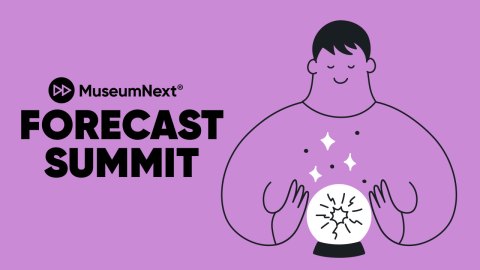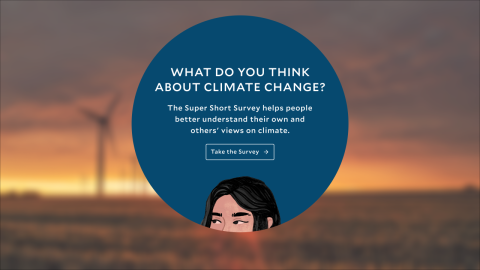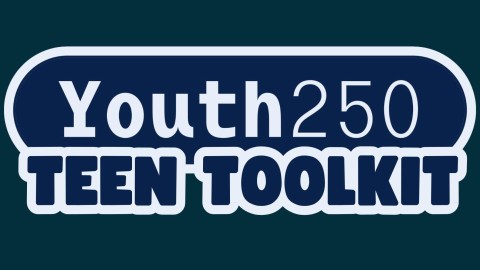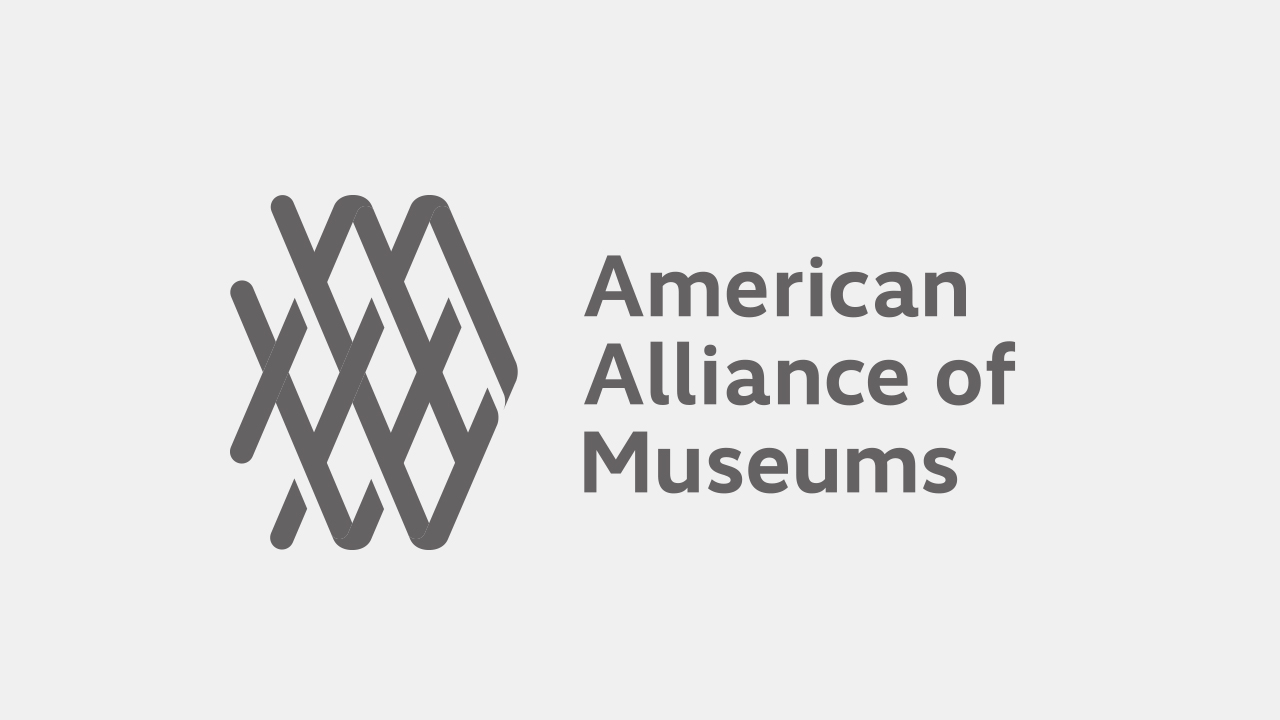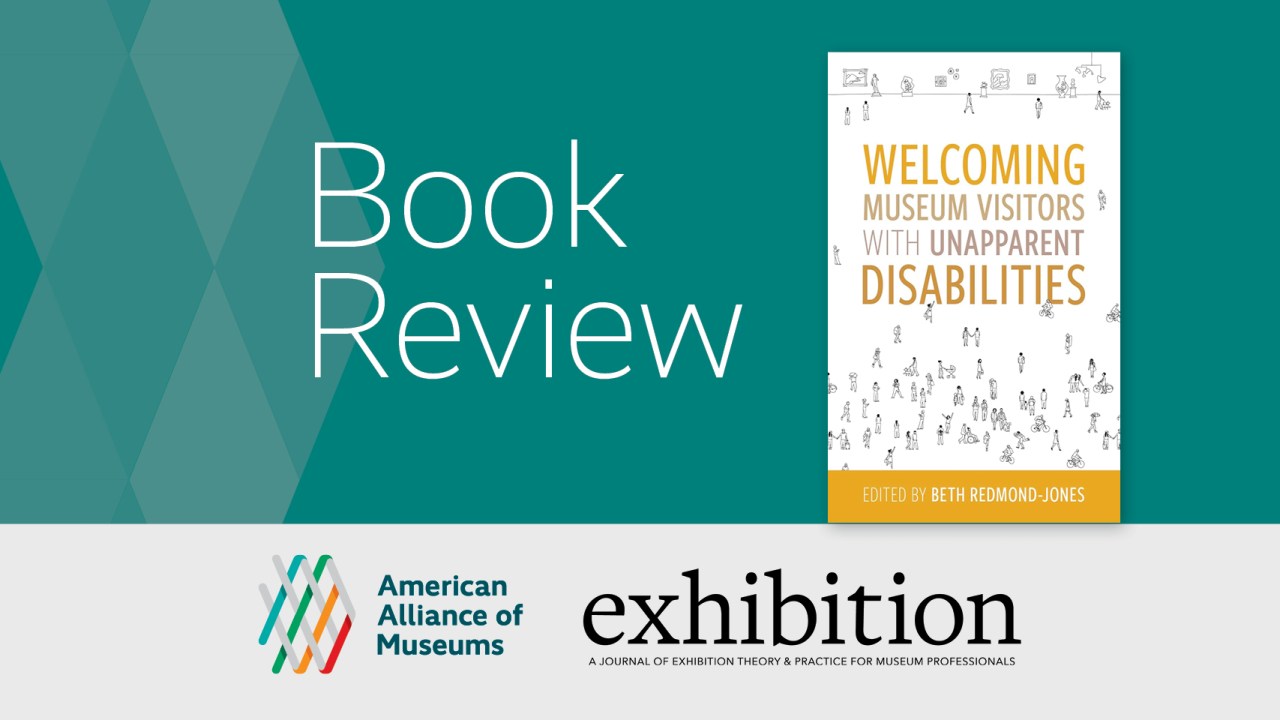
This book review first appeared in the journal Exhibition (Spring 2025) Vol. 44 No. 1 and is reproduced with permission. If you don’t read the journal, become a member to receive your digital copy of the full upcoming issues or purchase the Spring 2025 issue.

Welcoming Museum Visitors with Unapparent Disabilities
Edited by Beth Redmond-Jones
Published by Rowman & Littlefield, 2024
214 pages
Reviewed by Violet Rose Arma. Violet Rose Arma (she/her/hers) is Curatorial Assistant & Administrative Support at the University of Arizona Museum of Art (UAMA) in Tucson, Arizona.
Welcoming Museum Visitors with Unapparent Disabilities addresses the gap in accessibility scholarship, which has mainly focused on museum accessibility in terms of physical and more apparent disabilities, shifting the dialogue toward those with unapparent—“not readily perceptible”—disabilities. Through thoughtfully selected personal accounts, essays, and case studies, editor Beth Redmond-Jones educates museum professionals on the importance of inclusive practice in the museum space.
Redmond-Jones identifies herself as an individual who has experienced her own mental health challenges in addition to acting as an observer of and caretaker for others with unapparent disabilities. She currently works as Director of Campus Planning and Development at Oregon Zoo, previously holding the position of Vice President of Exhibitions at the Monterey Bay Aquarium. In addition to her 30 years of expertise in the museum field, she brings her voice to this volume, adding an empathetic and gracious perspective to the topic of museum accessibility. Redmond-Jones describes museums as places that have allowed her family “to have a sense of normalcy while fulfilling our psychological needs.” Conversely, she also calls attention to the cruelty and ignorance she and her family have faced during museum visits, which “ranged from side glances, to glares, to even blatant comments including…‘People shouldn’t bring people like that to a museum.’” These experiences alerted her to a glaring gap in the education of many museum professionals: learning how to be inclusive of underrepresented populations, including those with unapparent disabilities.
Overview
Following the Preface, Acknowledgements, and Introduction, Welcoming Museum Visitors with Unapparent Disabilities is divided into four distinct sections: Autism Spectrum Disorder, Postpartum Depression and Grief, Dementia, and Coexisting Conditions. The book concludes with an index and biographies of the editor and contributors.
In the Introduction, Redmond-Jones outlines information pertaining to the Americans with Disabilities Act (ADA), terminology and language use, and the organization of the text, stating that “museums continue to implement changes to make their spaces more accessible and inclusive, but we still have a long way to go, especially for those with unapparent disabilities.” She chose the term unapparent disability after careful research, considering the connotations and definitions associated with various combinations of words. Both person-first and identity-first language is used within the book, as each contributor has chosen the terminology they prefer.
Each of the four main section begins with a framing chapter that outlines diagnostic criteria with guidance from the International Classification of Diseases 11th Revision (ICD-11) and the Diagnostic and Statistical Manual of Mental Disorders, fifth edition—resources used by medical professionals to classify mental health disorders.[1] Each of these chapters is followed by one to two personal statements from individuals and caregivers who have lived experience with the unapparent disability featured in that section. These accounts provide a variety of perspectives and writing styles that add texture to the volume. Two case studies then showcase how museums have developed various programs, exhibitions, and initiatives for individuals with the specific disability outlined in the section. This structure gives a holistic view of each unapparent disability, providing information in the form of facts, lived experience, and relevant examples.
Part I: Autism Spectrum Disorder
Autism spectrum disorder is experienced by one in 100 children worldwide.[2] This general term refers to a group of complex neurodevelopmental disorders that can occur on a broad spectrum, impacting social communication and behavior. Following the framing chapter, readers are introduced to Austin Jones, an artist with autism who does not have a sensory processing disorder, who explains the qualities he finds the most soothing within a museum, including “minimal fancy effects, and fun and interactive exhibits.” Then, Rebecca Newman, a college student with a sensory processing disorder and autism, explains her complicated relationship with museums, detailing how she counteracts sensory overload during visits by taking photographs that she can investigate later.
Following these first-hand accounts, Michael Shanklin, Inaugural Executive Director of kidSTREAM Children’s Museum in Camarillo, California, introduces readers to this still-in-development museum. While planning their exhibition space, museum staff engaged with multiple stakeholders, including a volunteer group of 13- to 18-year-olds with autism. Their feedback guided the design of the museum’s sensory room, sensory backpacks, signage, an app, learning kits, and many other access-centered initiatives.
In the second case study, Charlotte J. Martin, Director of Access Initiatives at the Intrepid Museum in New York City, discusses the museum’s aim to provide a continuum of experiences for visitors with the help of their Autism Advisory Council, enabling equitable access to content. In addition to working to create a more accessible place for visitors, the Intrepid Museum has taken steps to develop part-time paid internships for adults with autism.
Part II: Grief and Postpartum Depression
About one in every 10 women experiences postpartum depression (PPD), and the global stillbirth rate is 13.9 per 1,000 births, making both relevant topics for discussion within this anthology.[3] Three of the five chapters—both personal accounts and one of the case studies—center the Jordan Schnitzer Museum of Art’s (JSMA) Art Is Prescription workshop. The workshop is “an integral component” of Esperanza Para las Madres (Hope for Mothers), a support group for Latina mothers working through the challenges of PPD, offered through Samaritan Health Services in Albany, Oregon. While these chapters demonstrate that JSMA is a leader in arts and wellness programming, an additional case study from another institution may have added breadth to this section.
Perhaps the most impactful chapter in the book, “Still Parents: Exploring Baby Loss Through Art and Creativity,” is authored by Lucy Turner, Imogen Holmes-Roe, Jo Richler, and Paul Kleiman. The organization Still Parents was founded by Turner, a member of the Civic Engagement and Education Team at the Whitworth Art Gallery in Manchester, UK, as a response to the stillbirth of her daughter Jenny in 2016. Turner collaborated with Richler and Kleiman, co-chairs of the Manchester branch of the Stillbirth and Neonatal Death Society (Sands) and Holmes-Roe, a curator at the Whitworth, to create a workshop series for individuals looking to share the experience of baby loss through artmaking. This evolved into Still Parents: Life After Baby Loss,an exhibition exploring infant loss that helped to expand understanding while also providing a sense of community. Though it might be thought than an exhibition on this topic would be too overwhelming, the Whitworth explains that “the evaluation undertaken in Still Parents…shows the exhibition’s capacity to be a positive, safe, and healing space…building empathy and enabling an emotional connection from visitors, whether or not they had personal experience with baby loss.”
Part III: Dementia
Characterized by memory and cognitive impairment and behavior changes, dementia is the leading cause of disability and dependency globally. “Someone in the world develops dementia every 3 seconds, and every year, there are nearly 10 million new cases.”[4] This number is steadily growing as our global population ages, with an estimated leap from 55 million to 139 million people living with the condition by 2050.[5]
Ann F. Burgunder, Licensed Master Social Worker (LMSW), shares her personal experience as a caregiver for her partner Ti, as well as her professional experience as the Special Projects Coordinator of the NYU Langone Family Support Program for caregivers of persons with dementia.[6] She emphasizes the impact of the arts and meaningful engagement on those with the condition and their caregivers, stating that her experiences and research related to museum access programs “have confirmed the efficacy of social engagement, cognitive stimulation, and an emphasis on the capabilities of the person with dementia to improve quality of life.”
Michelle Kindleysides, Head of Health and Wellbeing at the Beamish Museum in County Durham, UK, introduces readers to the organization’s approach to supporting those with dementia. Museum professionals provide a welcoming space with prompts that inspire conversation. Working in partnership with an occupational therapist (OT), the museum’s Health and Wellbeing Team holds an eight-week support group for men with dementia and their caregivers that has served as a blueprint for other groups and activities over the past nine years.
In the final chapter in this section, Redmond-Jones interviews Yoshinori Ichihashi, former director of the Shōwa Era Lifestyle Museum in Kitanagoya, Japan. To build relationships within the elderly community and address social issues associated with the aging population, the museum began its Reminiscence Project, which invites seniors to share their memories using nostalgic tools and objects. This program also includes intergenerational workshops, helping participants live a more active and fulfilled life.
Part IV: Coexisting Conditions
The fourth and final part of the book discusses coexisting conditions, defined as the presence of two or more mental health disorders.[7] Lena Jones, a student at Cabrillo Community College in Santa Cruz, California, shares a personal account of her experience of museums as places of wonder, joy, and exploration, calling for exhibits that are designed to be inclusive to all disabilities.
Researchers Grace Barry, Katherine N. Cotter, and James O. Pawelski from the Humanities and Human Flourishing Lab in the Positive Psychology Center at the University of Pennsylvania emphasize the ability of art museums to enhance human flourishing. They acknowledge that well-being looks different for those with disabilities and call for a greater emphasis on visitor health within museum spaces.
The last chapter, by Heidi Rosenström of Heureka, the Finnish Science Centre, discusses the process of creating Heureka Goes Crazy—an exhibition centered around mental health. This provocative title was unanimously approved by “experience experts,” a group of people who live or have lived with mental disorders/disabilities assembled by the museum. The experts contributed to decisions throughout the exhibition design process, assisting with the identification of themes, including societal views of mental health, stories from people living with mental illnesses, and interactive activities encouraging the exploration of human emotion. The exhibition traveled to other countries, and the cultural differences between locations highlights discrepancies in the view and treatment of mental illness on a global scale. For example, when the exhibition was shown at the Science Museum of Minnesota, the title was changed to Mental Health: Mind Matters to better suit U.S. audiences.
Conclusion
Each personal account and case study within Welcoming Museum Visitors with Unapparent Disabilities aligns with “nothing about us, without us,” uplifting the voices of those with unapparent disabilities and their allies within the museum sector. Varied chapter lengths and structures encourage further reading and engagement. Each chapter is strong individually, but in combination, they create a nuanced view of each unapparent disability.
Though Redmond-Jones does a fantastic job compiling diverse stories and case studies, there are a few areas that could be added and expanded upon to create a more well-rounded view of the topic. Most case studies concern programming with less of an emphasis on exhibition-related offerings. While this may speak to the large role programming plays in facilitating an accessible museum experience, it would have been beneficial to highlight more examples of successful exhibition design elements within each section.
Although coexisting conditions are discussed in the final section of the book, anxiety and depression are not individually addressed. Anxiety disorders are experienced by 4 percent of the global population, making them the most common mental disorders.[8] Depression is close behind at 3.8 percent of the global population.[9] In a future edition, it might be vaulable to include case studies or statements that explore each of these conditions individually, maximizing the opportunity for connection and learning for readers.
This anthology inspires a range of emotions, from anger and sadness to profound empathy and gratitude. According to the World Health Organization, “1.3 billion people experience significant disability. This represents 16% of the world’s population.”[10] This substantial number demonstrates why museum staff have an ethical obligation to consider visitors with both apparent and unapparent disabilities within programming, exhibition design, and beyond. This book is a must-read for museum professionals, highlighting various ways cultural institutions can consider and uplift a vast portion of their audiences through access-related initiatives, leading to more equitable and just outcomes for all audiences.
[1] “ICD-11: International Classification of Diseases 11th Revision,” accessed January 24, 2025, icd.who.int/en; and American Psychiatric Association, DSM-5 Task Force, Diagnostic and Statistical Manual of Mental Disorders: DSM-5™, 5th ed., (American Psychiatric Publishing, Inc., 2013), doi.org/10.1176/appi.books.9780890425596.
[2] “Autism,” World Health Organization, November 15, 2023, www.who.int/news-room/fact-sheets/detail/autism-spectrum-disorders.
[3] Jenna Carberg, “Postpartum Depression Statistics: Research and Data on PPD,” ed. Kimberly Langdon, MD, PostpartumDepression.org, April 2, 2024, www.postpartumdepression.org/resources/statistics/; and “Stillbirth,” UNICEF, January 9, 2023, data.unicef.org/topic/child-survival/stillbirths/.
[4] “Dementia,” World Health Organization, March 15, 2023, www.who.int/news-room/fact-sheets/detail/dementia.
[5] “Global Status Report on the Public Health Response to Dementia,” World Health Organization, September 1, 2021, www.who.int/publications/i/item/9789240033245.
[6] NYU Langone is a major medical center in New York City.
[7] Shishira Sreenivas, “What Is Comorbidity?” WebMD, November 17, 2021, www.webmd.com/a-to-z-guides/what-is-comorbidity.
[8] “Anxiety Disorders,” World Health Organization, September 27, 2023, www.who.int/news-room/fact-sheets/detail/anxiety-disorders.
[9] “Depressive Disorder (Depression),” World Health Organization, March 31, 2023, www.who.int/news-room/fact-sheets/detail/depression.
[10] “Disability,” World Health Organization, January 27, 2020, www.who.int/health-topics/disability.

